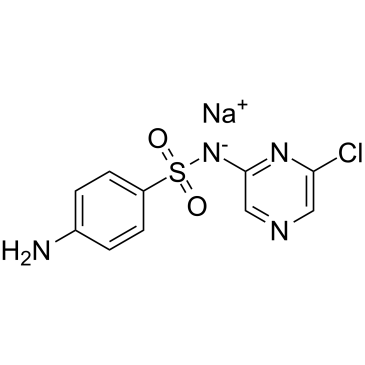| Description |
Sulfaclozine sodium (Sulfachloropyrazine sodium) is an efficacious sulphonamide derivative with antibacterial and anticoccidial effects. Sulfaclozine sodium is commonly used for the treatment of various poultry diseases (particularly, collibacteriosis, fowl cholera and coccidiosis)[1].
|
| Related Catalog |
|
| Target |
Bacterial; Parasite[1]
|
| In Vitro |
The elimination of Sulfaclozine in the three systems: UV/TiO2, UV/K2S2O8, and UV/TiO2/K2S2O8. Sulfaclozine is weakly adsorbed on the surface of TiO2 at pH 7 (< 5%) but efficiently eliminated with the following three systems: UV/TiO2, UV/K2S2O8, and UV/TiO2/K2S2O8 in ultra pure water. Moreover, 12 of Sulfaclozine by-products are identified and reaction pathways show that, in addition of •OH and SO4•− radicals, the conduction-band electrons are responsible for the formation of some main by-products either directly or by the formation of superoxide radicals[2].
|
| In Vivo |
Sulfaclozine (60 mg/kg; intravenous injection or oral administration; male broiler chickens) can be used primarily for the treatment of parasitic and microbial infections of the digestive tract rather than for the treatment of systemic infections[1]. Animal Model: 14 male broiler chickens (30-day-old)[1] Dosage: 60 mg/kg Administration: Intravenous injection or oral administration (Pharmacokinetic Analysis) Result: Serum drug concentrations at 0.083, 0.50, 2, 6, 24 and 72h were determined to be 99.62, 83.50, 72.68, 58.43, 38.66 and 13.14 μg/mL, respectively, by intravenous injection. By oral administration were determined as 4.33, 7.95, 16.46, 22.88, 16.03 and 5.74 μg/mL, respectively.
|
| References |
[1]. Sentepe I, et al. Pharmacokinetic of sulfaclozine in broiler chickens. Food Chem Toxicol. 2010 Jan;48(1):448-451. [2]. Ismail L, et al. Effect of water constituents on the degradation of sulfaclozine in the three systems: UV/TiO2, UV/K2S2O8, and UV/TiO2/K2S2O8. Environ Sci Pollut Res Int. 2018 Jan;25(3):2651-2663.
|


